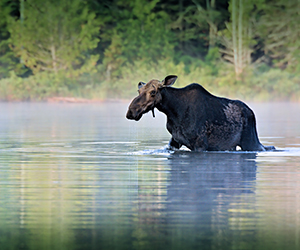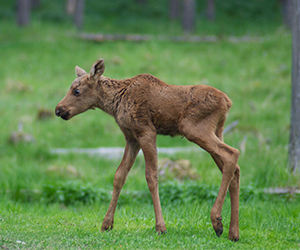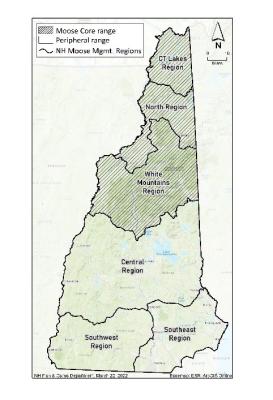Moose
Alces alces
Moose are the largest member of the deer family. Some adult moose weigh over 1,000 pounds! These large animals survive by eating just leaves, twigs, and aquatic vegetation. Often seen near water, moose are skilled swimmers, and can even dive.
Moose occur throughout New Hampshire and are most numerous north of the White Mountains. New Hampshire is at the southern extent of moose range in North America.
Physical Description
 Moose are big. An adult moose, averaging 1,000 pounds and standing 6 feet at the shoulder, is the largest land mammal in New Hampshire. Bulls and cows have different coloration patterns. Bulls have a dark brown or black muzzle, while the cows’ face is light brown. Cows also have a white patch of fur just beneath their tail.
Moose are big. An adult moose, averaging 1,000 pounds and standing 6 feet at the shoulder, is the largest land mammal in New Hampshire. Bulls and cows have different coloration patterns. Bulls have a dark brown or black muzzle, while the cows’ face is light brown. Cows also have a white patch of fur just beneath their tail.
Only bulls grow antlers. Antler growth begins in March or April and is completed by August or September when the velvet is shed. Antlers are dropped starting in November; young bulls may retain their antlers into early spring. Yearlings develop a spike or fork; adults develop antlers that may weigh up to 40 pounds with wide sweeping palms with many long tines.
Habitat and Life History
Moose are herbivores, browsing on the twigs and leaves of woody vegetation such as aspen, maple, birch, and willow. In summer, aquatic vegetation is often part of their diet. Moose consume 25-45 pounds of vegetation per day.
The life strategy of a moose is to fill their stomach then rest, chewing their cud and monitoring for predators. A typical day involves 5-9 bouts of feeding and resting with 97% of their time spent on these activities.
Ideal moose habitat is forested areas with an interspersion of young and older forest stands. Young forest, regenerating forest 1-12 feet tall (interactive WMA map) provides abundant vegetation for forage. It was traditionally created by wind throw, insect outbreaks, ice damage and wildfire, and now most frequently by logging. Older forest stands provide cover for moose to rest and stands with conifers, such as balsam fir and spruce, are important areas of shade and shelter.
 The breeding season, or rut, extends from mid-September through mid-October. Both bulls and cows travel more during this time in pursuit of mates. Bulls defend a cow they're pursuing, driving off younger bulls and sparring with more evenly matched opponents or youngsters bold enough to test their strength. After the rut, bulls may be seen eating together fattening up for the upcoming winter.
The breeding season, or rut, extends from mid-September through mid-October. Both bulls and cows travel more during this time in pursuit of mates. Bulls defend a cow they're pursuing, driving off younger bulls and sparring with more evenly matched opponents or youngsters bold enough to test their strength. After the rut, bulls may be seen eating together fattening up for the upcoming winter.
Cows give birth to one calf, or two when they are in good physical condition. Similarly, a cow can give birth at two years old when her physical condition is good, but it is commonly more delayed to three years old. Calves are born in mid-May or early June, and weigh 25-35 pounds. They're reddish brown with no spots. By fall, they weigh 300-400 pounds. Cows have been known to kill wolves, grizzlies, black bear, and people in defense of their calves.
Moose may live 20 years, but average lifespan is 10-12 years. They die from various causes including winter tick parasitism, brainworm, and moose-vehicle collisions.
Distribution and Abundance
 Moose occur in all ten counties of New Hampshire, with the highest densities in the in northern areas. Moose are naturally a species of the boreal forest. The transitional northern hardwood-boreal forest and interspersed wetlands that occurs in large blocks of undeveloped land in northern and western New Hampshire is more ideal for moose than habitat elsewhere in the state. During a year, moose home ranges vary from less than one square mile to more than 25, depending on the season.
Moose occur in all ten counties of New Hampshire, with the highest densities in the in northern areas. Moose are naturally a species of the boreal forest. The transitional northern hardwood-boreal forest and interspersed wetlands that occurs in large blocks of undeveloped land in northern and western New Hampshire is more ideal for moose than habitat elsewhere in the state. During a year, moose home ranges vary from less than one square mile to more than 25, depending on the season.
Since colonial times, widespread moose in New Hampshire are a relatively recent development. In the mid-1800s, fewer than 15 moose existed in New Hampshire due to habitat loss brought on by the clearing of forests for agriculture. Eventually, abandoned farmlands and changes in forest practices in the late 20th century created a mosaic of mature and young forests that restored moose habitat. The moose population peaked in the late 1990s at 7,000-8,000, and has since declined to about 3,000-4,000. To learn more, read the 2015 Moose Assessment.
Factors Influencing NH Moose
Habitat: Moose need large areas of forest with a mix of young trees and shrubs (trees/shrubs 1-12 feet tall) for food and older forest for cover. This habitat type is mainly created by timber harvesting.
Winter tick (Dermacentor albipictus): This native species of tick causes mortality of young moose and suppressed reproduction in adult moose when high infestations (30,000+ ticks/moose) occur. High moose density and short winters result in higher tick infestations. Learn more about winter ticks
Brainworm (P. tenuis): This worm primarily occurs in the brain of white-tailed deer and has minimal effect on them. However, infected moose develop neurologic impairment and die. High deer density can result in more brainworm infection and mortality in moose, and may keep the moose population low. Learn more about brainworm
Development: Development removes moose habitat and fragments existing habitat with roads, which increases risk of moose-vehicle collisions. This is affecting all wildlife statewide.
What can residents do to help moose?
- Support local and regional land conservation groups. Work within your town to conserve open space.
- Support balanced forest management that creates a mix of young forests (young forests initiative) and conifer cover.
- Climate change leads to winter ticks and brainworm, threatening moose in New Hampshire. Become informed on climate change and take steps to reduce your carbon footprint.
Management
NHFG monitors and manages moose at the regional level. Each region is divided into wildlife management units (WMUs) that have similar types of forest and terrain.
Monitoring efforts focus on moose abundance and health.
Abundance is tracked using the sighting rate of moose by deer hunters. This technique was developed in 2000 by surveying deer hunters for their observations of moose in a specific area and combining this information with data from an aerial infrared survey of moose in the same area. Researchers use this data to track population change over time.
Health data includes demographics, physical condition, and parasite abundance. Demographic data is the ratio of bulls to cows and ratio of calves to cows, based on hunter sightings. Physical condition information comes from moose harvested by hunters, and includes weight (heavy moose is a healthy moose!), reproductive status (scars in the ovaries indicate pregnancy), and antler characteristics. Parasite monitoring includes tracking the annual impact of winter ticks using counts on harvested moose. Brainworm is monitored through blood and brain samples.
Moose management goals in New Hampshire are detailed in the 2016-2025 Game Management Plan and include:
- Managing for a level of moose abundance that balances ecological factors and the desires of residents.
- Maintaining good physical condition of moose and a balanced sex ratio in the population.
- Educating the public to further understanding.
- Conserving moose habitat by working with federal and private partners.
Moose population characteristics currently indicate that moose can be harvested without threatening the viability of the population, so moose hunting is offered as a recreation option. The New Hampshire moose hunt is strictly managed using a permit system. For more information on moose hunting, see the Moose Hunting webpage and 2016-2025 Game Management Plan.



